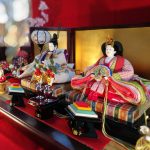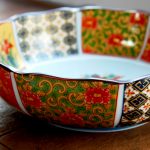Although it does not very often snow any longer, cold winds are still blowing. However, the air has gradually become warmer. Looking up at the hill behind my house, I spied the season’s first small white blossoms on the branches of two ume plum trees. And while climbing the hill to check out the blossoms, I heard a bush warbler singing. That was the first bush warbler song I had heard from the forest near my house this year, and it made me happy to have heard this sign of spring. It is still cold, but plants are beginning to flower.
I heard that ume blossom festivals were held in various places that week. Wakaki-cho also has one. The nature-experience tourist ume orchard Happy Farmer Ohyakusho-san, located on a hill on the way to Takeo Kita Junior High School, has already opened to show ume blossoms to visitors. Despite buying ume plums there many times, I had not attended the ume blossom festival held there, until I finally visited it for the first time this year.

The Thai word for ume plum is buai. In Saga, the season of ume blossoms is from mid-February to early March. Because this winter has been longer than usual, ume blossoms also seem to have appeared slightly later than usual.
Arriving at the ume orchard, I saw regular rows of ume trees, whose branches were covered with small white blossoms. Taking a more careful look, I found ume trees with deep pink blossoms at a distance. Intrigued by the difference, I asked Ms. Miyuki Okoba, the owner of the ume orchard, about it. She told me that the orchard had two types of ume trees: trees grown to harvest ume plums and trees grown simply to appreciate the beauty of their blossoms.

The orchard owner said, “You can see a pale pink line in the middle of each petal of the white blossoms. These ume trees are of a variety called Nanko-ume, and produce large fruits. We planted them next to trees of the Koume variety, which bear small blossoms with five petals. We have tied green cloth around the trunks of the Koume trees, so that the trees of this variety can be easily recognized.”
“There is a reason why we are growing multiple varieties in this way. That is because the trees would not produce fruits if we grew only one variety of ume,” Ms. Okoba said, and pointed out a beautiful ume tree in front of us.

“Can you see how many petals overlap with each other? They look beautiful, don’t they? This variety is grown only to enjoy its beautiful blossoms, and does not produce fruits. These deep pink ume blossoms are called “kobai” (red ume), and turn even the inside of branches pink. These blossoms can be also used for dyeing.”

“Branches with pale pink blossoms are drooping. These trees are weeping ume plums. Weeping cherries are famous, but ume plums have a similar variety.”
I see. Today I learned various new things. Different plant species bloom in different times in the year. While ume plums begin to bloom in February, cherries start blossoming in March or later. It is hard for me to distinguish the blossoms of these two species even by looking closely at photos, but I believe it is important to observe the blossoms by my own eyes. By doing so, I can discover the beauty of cherry blossoms and the beauty of ume blossoms.
We have fine weather and warm sunlight today. Cool winds bring the aroma of ume blossoms to me. When I had a cool ume drink made with ume syrup, while looking at ume trees in bloom and talking about the blossoms while seated, I felt the drink was sweeter and more refreshing than usual.

Author name: Noi
Hometown: Bangkok, Thailand
I live in Wakaki-cho, Takeo City, Saga Prefecture, together with my Japanese husband, raising our child.
In Thailand, I used to do art and publication-related work.
I have a Kyushu Special Zone Guide-interpreter’s license (in Thai).

 TH
TH KR
KR JP
JP

